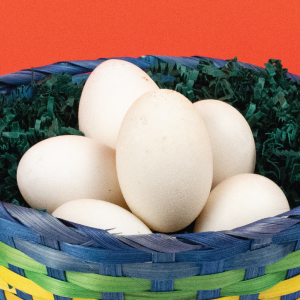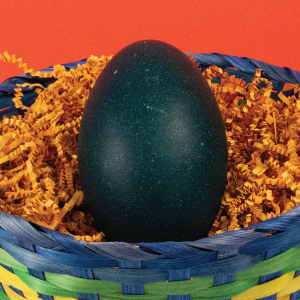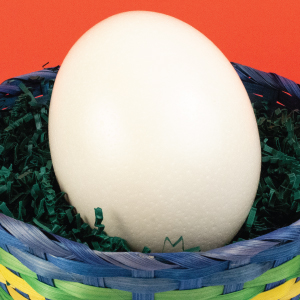
Get Egg-cited for Spring with a Jungle Jim’s Egg Hunt
Back to feed- Posted: 4/12/2019
- Categories: International
Jungle Jim’s carries more than just chicken eggs. Go on an egg hunt through the store to find these varieties and more!
Quail Eggs
Quail eggs are tiny white eggs with brown speckles that are full of important nutrients. Interestingly, these eggs have a larger yolk and a smaller egg white, which gives them more flavor. Some describe the flavor of quail eggs as “gamey,” but most people like the taste. As with anything, it’s important to consume quail eggs in moderation because the larger yolk-to-white ratio does mean that they are slightly higher in cholesterol than chicken eggs. Most people eat about 3 to 5 of these eggs at once, which is the equivalent of eating about 1 chicken egg. These eggs can be cooked in a pan, boiled, or baked. Just watch the cooking time— since quail eggs are very small, you won’t have to cook them as long as chicken eggs.
Cooked Salted Duck Eggs
Salted duck eggs are made by soaking duck eggs in brine or coating each egg with a thick layer of damp charcoal to cure the eggs. Once the eggs have been salt-cured, they are typically steamed or boiled, then vacuum-sealed in plastic. This cooking method began as a way to preserve eggs, but now many people make salted duck eggs for enjoyment, not just necessity, as the salt-curing process gives these eggs a very unique taste. While the egg whites of salted duck eggs are very rubbery and dense, the yolks become creamy and oily with a distinctly salty, umami flavor. These are believed to have originated in Chinese cuisine, but are also eaten in Vietnam, Thailand, Malaysia, the Phillippines, and Indonesia.
Duck Eggs
Usually about 50% larger than chicken eggs, duck eggs are delicious, extremely nutritious, and versatile. Because they have a much larger yolk than chicken eggs, duck eggs are rich in protein and omega-3 fatty acids. Duck eggs are regulated by the USDA and are just as safe to eat as chicken eggs. In fact, you can cook duck eggs just like you cook chicken eggs. Because of their higher fat content, they make extremely rich and creamy scrambled eggs.
Balut
Varieties of balut are eaten in several Asian countries, but it is most common in and is believed to have originated in the Phillippines. Balut is made by boiling a 16 to 20 day-old fertilized duck egg. Once cooked, the egg is peeled and then eaten out of hand, often with a pinch of salt or a splash of vinegar. Though balut can be off-putting to those unfamiliar with the food, the taste is said to be worth the uncomfortable sight of the half-developed duck embryo. We’ll let you decide if you’re willing to brave this unique delicacy.
Ostrich Eggs
Found primarily in Africa, ostriches are, on average, 7 to 9 feet tall. So, it’s no surprise that they lay the largest eggs in the world! In fact, ostrich eggs are larger than many fossilized dinosaur eggs. One ostrich egg can weigh up to 5 pounds, but more commonly only weighs about 3 pounds and is equal to about two dozen chicken eggs. Once cooked, an ostrich egg contains a whopping 2,000 calories and can feed 18 people! Ostrich eggs can be boiled or fried like chicken eggs, but the cooking time will be much, much longer!
Emu Eggs
At 4 or 5 feet tall, emus are the second-largest living bird in the world, surpassed only by the ostrich. Emus live exclusively in Australia, where they roam the outback eating vegetation and insects. Emus eggs have a deep, emerald green hue that acts as camouflage in the grass, which is where emus make their nests. The beautiful, striking color is only part of what makes these eggs special. The huge 2-pound egg is the equivalent of a dozen chicken eggs and can serve up to six people! Emu eggs have a rich, decadent taste with a creamy texture and make great omelets.






